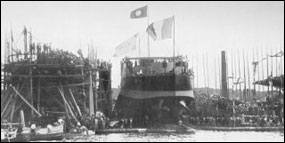| Mexico
at Sea
By Mike Bennighof, Ph.D.
February 2016
Despite Mexico’s huge cultural, economic
and political influence and very long coastline,
she has never been known as a naval power.
The Mexican Empire declared in 1821 was a
very large state, stretching from what today
is British Columbia to Panama, but with a
very weak hold on much of this territory.
Central America broke away in 1823 and Texas
in 1835, and a decade later what would become
the American Southwest was lost after a disastrous
war with the United States.
In all of these conflicts, the Mexican Navy
played little role. In 1829, a Spanish squadron
from Cuba landed troops at Veracruz in an
abortive attempt to reconquer Mexico for Spain.
A Mexican army besieged them there and eventually
forced their surrender, but the tiny Mexican
navy played no part.

Launching the Brazilian Deodoro,
later Mexico’s battleship Anahuac.
|
When Texas rose in revolt in 1835, the tiny
Texas Navy was able to fight Mexico’s
little fleet to a standstill. Mexico, with
just three brigs and two schooners plus a
handful of revenue cutters, faced several
converted merchantmen flying the Lone Star
flag. The Mexicans also fought a series of
naval skirmishes resulting from a French intervention
in 1838 and a revolt in Yucatan the next year.
The Mexicans blockaded Texas in 1837, but
their squadron was shot up by a single American
warship, the sloop Natchez, which captured
the brig General Urrea. The federal
government apologized and ordered her returned,
but it was a great embarrassment for the Mexican
fleet. Later that year two Texan warships
prowled the Mexican coast, burning villages
and capturing merchant ships, until a storm
drove them ashore.
The naval war continued, with the Texans
allying with Yucatan and the Mexicans buying
new steam-powered warships, including the
sidewheeler Guadeloupe, the world’s
first iron-hulled warship. In the summer of
1842 Mexican Cdr. Tomás Marín
led an expedition that wiped out Yucatan’s
navy. The next summer six Mexican warships,
their crews badly depleted by yellow fever,
fought a pair of Texan ships off Yucatan,
with no result.
The Mexican fleet was of no use against
the United States; the central government
forbade privateering and the regular warships
were not match for the American fleet. The
Americans had control of the sea and when
a large American fleet landed troop at Veracruz
in 1847, the Mexcian warships did not interfere.
In the decades of unrest that followed,
the Mexican navy seldom received much interest.
The French-supported Emperor Maximilian had
been commander of the Austrian navy and hoped
to build a modern fleet for his new country,
but this project had very low priority. His
successor, the dictator Porfirio Diaz, ordered
a series of four warships in the mid-1870s,
designed to act as combine gunboat-transports.
A small training cruiser was added in 1891,
and four new gunboat-transports were ordered
in 1902 to replace the first series. Two small
cruiser-transports joined the fleet in 1908.
The largest of them, the 1,8000-ton General
Guerrero, was fitted to carry 45 horses and
several field pieces in addition to her standard
armament of six 4-inch guns.
Diaz was overthrown in 1910, starting over
a decade of civil war and general unrest in
which the tiny navy played little part. In
1924, Mexico began a careful rebuilding of
her naval strength. The Mexicans scrapped
a number of their older warships and purchased
the coast defense battleship Maréchal
Deodoro from Brazil for the bargain price
of 8,000 Brazilian contos. The Brazilians
then used the take to build a mine-laying
submarine in Italy. The Mexicans re-named
their new battleship Anahuac, after
the Aztec name for the Valley of Mexico, and used
her mostly for training for the next 14 years.
She appears in Great
War at Sea: U.S. Navy Plan Gold in
her Mexican colors; as a Brazilian unit she’s
found in the out-of-print Cone
of Fire.
The Mexican goverment established warm relations
with the Spanish Republic in the mid-1930s,
and during the Spanish Civil War Mexico was
a staunch supporter of the Republican cause,
provinding the largest contingent of foreign
volunteers. Before the war broke out Mexico
bought three patrol sloops, a new gunboat-transport
and 10 small patrol craft from Spanish shipyards.
Mexico was the only member of the League of
Nations to condemn the German annexation of
Austria in 1938, and remained a determined
foe of facsism during World War II as the
only Latin American nation to actively participate
in the war against Japan.
Click here to order U.S. Navy Plan
Gold now!
Mike Bennighof is president of Avalanche Press and holds a doctorate in history from Emory University. A Fulbright Scholar and award-winning journalist, he has published over 100 books, games and articles on historical subjects.
He lives in Birmingham, Alabama with his wife, three children and his dog, Leopold.
|
